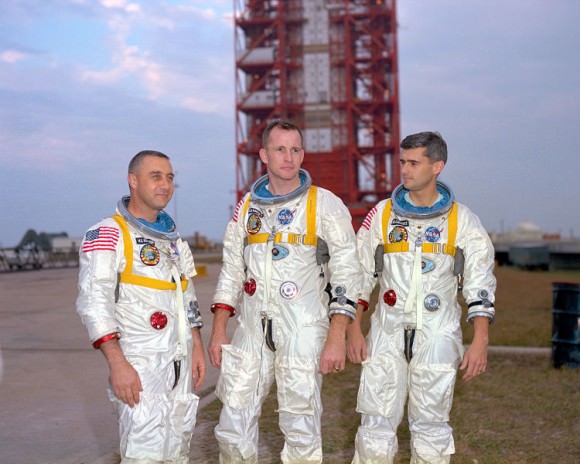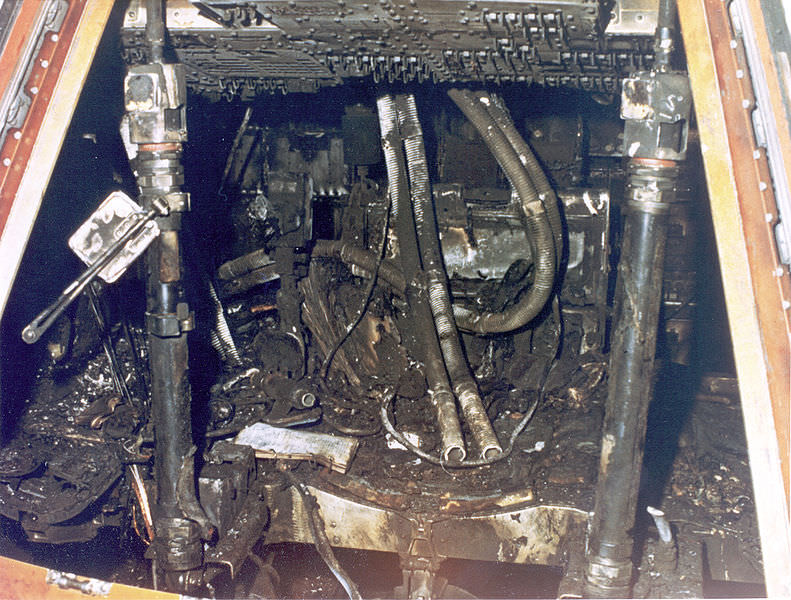[/caption]
Note: To celebrate the 40th anniversary of the Apollo 13 mission, for 13 days, Universe Today will feature “13 Things That Saved Apollo 13,” discussing different turning points of the mission with NASA engineer Jerry Woodfill.
“Far better is it to dare mighty things, to win glorious triumphs, even though checkered by failure than to rank with those poor spirits who neither enjoy much nor suffer much, because they live in a gray twilight that knows not victory nor defeat.” – Theodore Roosevelt
It’s hard to chronicle any of the Apollo flights without mentioning the Apollo 1 fire. And while many believe the Apollo program perhaps wouldn’t have succeeded without that disaster, the sacrifice made by Gus Grissom, Ed White and Roger Chaffee definitely saved the crew of Apollo 13.
“Among the early space missions, I’ve always believed that the greatest courage was needed by their first crews,” said Apollo engineer Jerry Woodfill. “Whether it was Al Shepard, the Apollo 1 crew, or shuttle astronauts John Young or Bob Crippen, the most likely danger would be the first time any new space craft was launched into space. Flaws in design or manufacture could very well be fatal during maiden missions.”

On January 27, 1967, during a test on the launch pad with the crew on board, tragedy struck when a flash fire started in the command module. With the pure oxygen environment inside the capsule, the fire quickly proved fatal for the crew before they or workers at the launch pad could get the hatch open. Although the ignition source of the fire was never conclusively identified, the astronauts’ deaths were attributed to a wide range of design and construction flaws in the early Apollo Command Module. The manned phase of the project was delayed for twenty months while these problems were fixed.
“To suggest the dire event of losing three brave astronauts contributing to Apollo 13’s rescue seems almost ludicrous,” said Woodfill, “but the evidence is striking. What Grissom, White and Chaffee contributed to the rescue of Apollo 13 makes them even more heroic than they were when they gave their lives so that men could go to the moon.”
The irony of the whole situation involves the hatch. Following Gus Grissom’s near fatal drowning when his Mercury capsule sank, the Apollo hatch had been redesigned to avoid the kind of unexpected actuation thought to have caused Grissom’s “Liberty Bell 7” to sink.

“Unfortunately, it led to a hatch impossible to open before the Apollo 1 crew expired,” said Woodfill. “Nevertheless, circumstances used Gus, Ed, and Roger’s sacrifice to save other crews in route to the Moon.”
NASA fire-proofed all future Apollo vehicles with non-flammable materials, used a pad atmosphere of a nitrogen/oxygen mix, and coated of all electrical connections to avoid short-circuits.
“Every switch contact and wire was coated with a moisture proofing substance called conformal coating,” said Woodfill. “Were it not for fire-proofing the Apollo command and service modules, Apollo 13, likely, could not have survived reentry. The cold, damp reentry module interior faced extreme condensation of water vapor from the astronauts’ breath. Droplets of water formed behind the display panels.”

Woodfill said when Apollo 13’s switches were activated for reentry, the interior would surely have burst into flame, were it not for the fireproofing. Condensed water droplets might have short-circuited panel switches, circuit breakers, and connector wiring.
Woodfill said America might never have landed a man on the Moon without Apollo 1. If a fire had occurred on the way to the Moon, it might have ended the will to land men there. “Imagine the horror of the world at such an event,” said Woodfill, “hearing the crew’s painful cries from deep space, ‘We’ve got a fire in the spacecraft.’”
Apollo 1 and the fireproofing of future Apollo spacecraft prevented such an event.
A favorite quote of many managers of the Apollo program, Woodfill said, is from President Theodore Roosevelt, the one posted at the top of this article.
“In a sense, the Apollo One mission was altogether different from Challenger, Columbia, and Apollo 13,” said Woodfill. “No one had dared such a mighty thing as to man the first Apollo spacecraft into orbit. And it, in this case, was fraught with suffering, failure and defeat, rather than a glorious triumph and victory.”
But later, it allowed for great triumph with the success of the Apollo program, and a defying of the odds of the Apollo 13 crew’s survival.
Tomorrow, Part 8: What the Explosion Didn’t Do
Additional articles from the “13 Things That Saved Apollo 13” series:
Part 2: The Hatch That Wouldn’t Close
Part 3: Charlie Duke’s Measles
Part 4: Using the LM for Propulsion
Part 5: Unexplained Shutdown of the Saturn V Center Engine
Part 6: Navigating by Earth’s Terminator
Part 8: The Command Module Wasn’t Severed
Part 12: Lunar Orbit Rendezvous
Part 13: The Mission Operations Team
Also:
Your Questions about Apollo 13 Answered by Jerry Woodfill (Part 1)
More Reader Questions about Apollo 13 Answered by Jerry Woodfill (part 2)
Final Round of Apollo 13 Questions Answered by Jerry Woodfill (part 3)
Never Before Published Images of Apollo 13’s Recovery
Listen to an interview of Jerry Woodfill on the 365 Days of Astronomy podcast.


Ah! That point was one of the points the “Apollo 13” movie didn’t spell out to clarify the seemingly unempirical amount of condensates vs non-shorting going on.
For myself, I simply assumed they over-dramatized the amount of water, Hollywood style. Instead it seems they tried to tell the real history and drama here, NASA style.
[In insufficient detail 🙁 . Oh, I seem to remember close ups of cabling and insulation, I haven’t checked tho’. But the point of it _all_ being treated specifically against shorts eluded me at the time.]
Also, since I’m commenting on this series: Good job, all! The attention to detail (archive photos, links) will make this one “a classical UT series”.